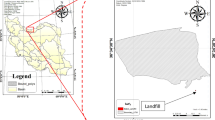Abstract
This study was inspired by the Klang Valley water crisis, for which bank infiltration (BI) is considered a potential solution. This paper presents a case study of the BI techniques, which evaluates the effects of groundwater pumping and BI operation on the installation of wells. This study also determines the effect of pumping rate on flow paths, travel time, the size of the pumping and capture zone delineation, and groundwater mixing in a pumping well in Jenderam Hilir, Malaysia. The proposed method performs infiltration safely and achieves the ideal pumping rate. Numerical modeling packages, MODFLOW and MODPATH (particle tracking) were used. Results indicate that the migration of river water into the aquifer is generally slow and depends on the pumping rate and distance from well to the river. Most water arrives at the well by the end of a pumping period of 1 to 5 days at 3,072 m3/day for test wells DW1 and DW2, and during simultaneous pumping for DW2 and PW1 for a well located 36 and 18 m, respectively, from the river. During the 9.7-day pumping period, 33 % of the water pumped from the DW1 well was river water, and 38 % of the water pumped from DW2 throughout 4.6 days was river water.





















Similar content being viewed by others
References
Abdel Fattah A, Langford R, Schulze-Makuch D (2008) Applications of particle-tracking techniques to bank infiltration: a case study from El Paso, Texas, USA. Environ Geol 55:505–515. doi:10.1007/s00254-007-0996-z
Anderson MP, Woessner WW (1992) Applied groundwater modeling; simulation of flow and advective transport. Academic, San Deigo, p 381
Arrifin J (2004) Development of sediment Transport model for rivers in Malaysia using regression analysis and artificial neural network. Ph.D. Thesis, University Science Malaysia, Penang
Chen XH (2001) Migration of induce–infiltrated stream water into nearby aquifer due to seasonal groundwater withdrawal. Groundw 39(5):721–728
DID (2005) Master Plan for the Management of the Langat River Basin. Department of Drainage and Irrigation Malaysia. Ministry of Natural Resources and Environment Malaysia, Kuala Lumpur, p 237
Doussan C, Ledoux E, Detay M (1998) River–groundwater exchange, bank filtration, and groundwater quality; ammonium behavior. J Environ Qual 27:1418–1427
Eckert P, Irmscher R (2006) Over 130 years of experience with riverbank filtration in Dusseldorf, Germany. J water Srt Aqua 55:283–291
Grishek T, Hiscock KM, Metschies T, Dennis PF, Nestler W (1998) Factors affecting denitrification during infiltration of river water into a sand and gravel aquifer in Saxony. Germany-Water Res 32(2):450–460
Hantush MS (1965) Wells near stream with semipervious beds. J Geophys Res 70(12):2829–2838
Jacobs LA, Van Funten HR, Keil R, Kuslys M (1988) Geochemical changes along a river-groundwater infiltration path; Glattfelden. Switzerland Geochim Cosmochim Acta 52(11):2693–2706
JICA, Minerals and Geosciences Department (MGD) (2002) The study on the sustainable groundwater resources and environmental for the Langat Basin in Malaysia, Vol 1–5, Japan International Cooperation Agency (JICA). Tokyo and Department of Minerals and Geoscience Malaysia, Kuala Lumpur
Kuhn W, Muller (2000) Riverbank filtration; an overview. J Am Water Works Assoc 92(12):60–69
McDonald MG, Harbaugh AW (1988) A modular three-dimensional finite-difference groundwater flow model. Techniques of Water resources Investigations 06-A1. United States Geological Survey, Reston
Pollock DW (1989) Documentation of computer program to compute and display pathlines using result from the US Geological Survey modular three dimensional finite-difference groundwater flow model. US Geological Survey open File-Report, Denver, pp 89–381
Ray C, Grischek T, Scubert J, Wang Z, Septh TF (2002) A perspective of riverbank filtration. J Am Water Works Assoc 94(4):149–160
Schwarzenbach RP, Giger W, Hoehn E, Schneider J (1983) Behavior of organic compounds during infiltration of river water to groundwater; field studies. Environ Sci Technol 17:472–479
Stuyfzand PJ, Kooiman JW (1996) Elimination of pollutants during artificial recharge and bank infiltration: A comparison. In; Kivimaki A-L, Suokko T (eds) Artificial recharge of groundwater. Proc. Int. Symp., Helsinki, 3–5 June 1996, pp 223–231
Von Gunten HR, Karametaxas G, Krähenbühl U, Kuslys M, Giovanoli R, Hoehn E, Keil R (1991) Seasonal biogeochemical cycles in riverborne groundwater. Geochim Cosmochim Acta 55(12):3597–3609
Waterloo (2005) Visual MODFLOWv 4/1 User’s Manual. Waterloo Hydrogeologic, Inc, Waterloo
Yusoff I, Ismail WMZW, Rahim BEA (2012) Simulation of horizontal well performance using Visual MODFLOW. Environ Earth Sci. doi:10.1007/s12665-012-1813-x
Author information
Authors and Affiliations
Corresponding author
Rights and permissions
About this article
Cite this article
Shamsuddin, M.K.N., Suratman, S., Zakaria, M.P. et al. Using particle tracking as a tool sustainable bank infiltration techniques: a case study in an alluvial area. Arab J Geosci 8, 1571–1590 (2015). https://doi.org/10.1007/s12517-014-1315-0
Received:
Accepted:
Published:
Issue Date:
DOI: https://doi.org/10.1007/s12517-014-1315-0




